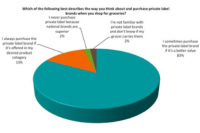Consumers Choose Walmart as Top Spot for Groceries
Some 27 percent of grocery purchasers say Walmart is the in-store retailer they get groceries from most, more than twice as many as Kroger, the next most chosen retailer, according to market research firm Packaged Facts in the report "U.S. Grocery Market Focus: The Walmart Food Shopper."
While Walmart may be behind the overall e-commerce curve, it is already a leading online grocery player. Packaged Facts reveals that 23 percent of online grocery purchasers claim Walmart is the one they use most for groceries, second only to Amazon, with 38 percent.
To build out its omnichannel grocery capabilities, Walmart has only just begun leveraging its roughly 4,000 Walmart-branded and 600 Sam's Club branded grocery and consumables-centric stores located across the U.S. and Puerto Rico. While these physical locations may place Walmart at a cost disadvantage when compared to pure-play internet grocers, they also give it distribution strengths that are hard to beat.
For example, Walmart's nascent click-and-collect strategy has already paid dividends. According to Packaged Facts' June 2018 online survey results, among respondent click-and-collectors, 42 percent identified Walmart as the pickup location for their last click-and-collect order. And loyal Walmart online grocery purchasers are 30 percent more likely than the average online grocery purchaser to cite in-store pickup/curbside service as a factor most important to influencing the choice of online grocery provider.
However, loyal Walmart online grocery purchasers are 75 percent less likely to cite subscription/repeat ordering services as a factor most important to influencing the choice of online grocery provider, an area Walmart may need to bolster. This may be especially true if it wants to draw more Amazon customers, who are 45 percent more likely to view subscription/repeat ordering services as an important factor.
Looking for a reprint of this article?
From high-res PDFs to custom plaques, order your copy today!





